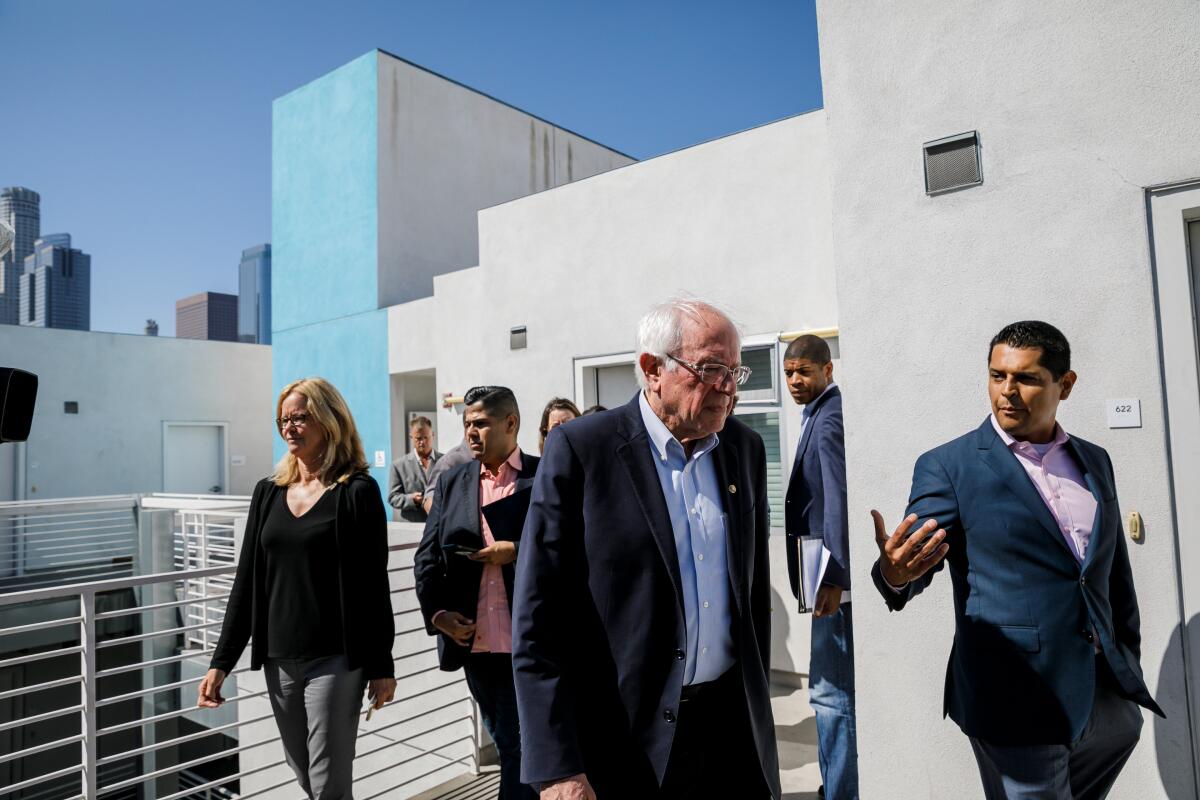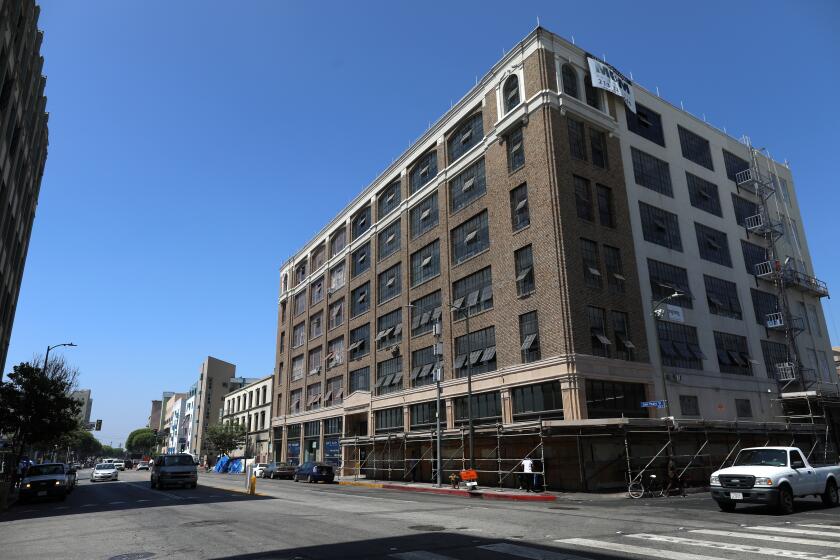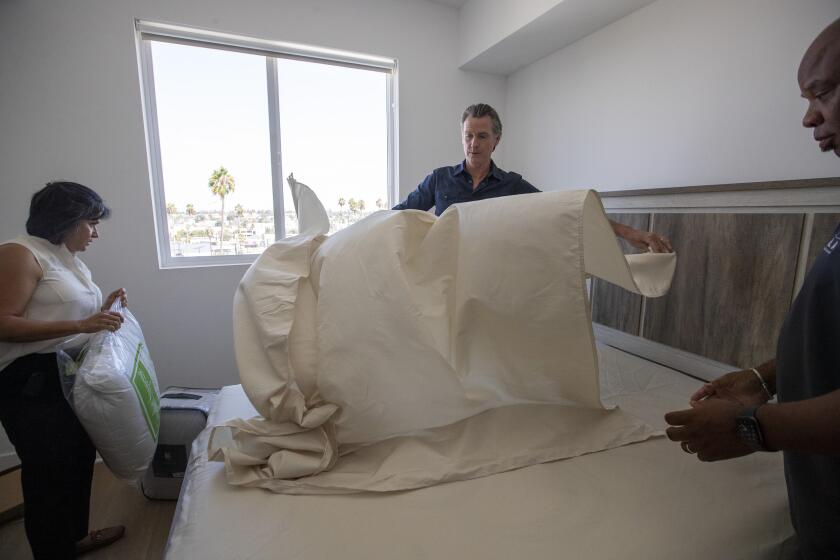Editorial: Skid Row Housing Trust’s downfall is a teachable moment for L.A., not a reason to give up

- Share via
For decades, single-room occupancy hotels in downtown Los Angeles made up the only available and affordable housing for the poorest of the poor. But after thousands of these residential buildings, known as SROs, were demolished, a group of community activists and downtown business leaders banded together in 1989 to create the nonprofit Skid Row Housing Trust with a mission both urgent and valiant: Stop the demolition of these buildings and preserve them for people who had nowhere else to go.
Eventually Skid Row Housing Trust would become one of the largest and best-known producers of desperately needed permanent supportive housing on skid row.
Yet the organization is now headed for financial ruin, its oldest housing stock deteriorating with no funds for repairs. The trust is existing on an infusion of hundreds of thousands of dollars in support from three philanthropic organizations as it seeks to transfer its nearly 30 properties to other permanent supportive housing developers.
There’s much talk about how difficult it is to cobble together multiple sources of financing to build permanent supportive housing for homeless people who will not be paying market rate rents. What’s infrequently discussed is how challenging it is to keep those buildings maintained once they are occupied.
Having any neighborhood officially designated for low-income people is akin to at least economic if not racial segregation.
Skid Row Housing Trust’s downfall is a cautionary tale of what can go wrong for owners and operators of permanent supportive housing. But it is not a warning to avoid building this kind of housing. L.A. can’t solve its homeless problem without it. Homeless people stop being homeless only when they get permanent housing — along with services to help keep them in that housing.
The city has rightly staked its plan for reducing homelessness on the creation of more permanent supportive housing and should not change course. But Mayor Karen Bass, other city leaders and affordable housing developers should heed the lessons from the trust’s problems. The primary one is to vigilantly and regularly assess the state of properties — and finances — and figure out how to finance rehab of buildings.
In the trust’s oldest buildings, rental vouchers didn’t begin to cover the costs of repairs and upkeep. Repairs were deferred to the point where they got worse and created more problems. In some cases, units were damaged by tenants suffering from mental illness who flooded their units with running water or even set them on fire.
When some units became open, they were so damaged they couldn’t be occupied until fixed — which the trust’s operators couldn’t afford to do. So the units sat empty, which meant less income from rent to fix repairs. The occupancy rate across all its properties averages about 78%, but the trust’s chief executive said occupancy rate is significantly lower in the buildings that need the most repair.
It’s up to the owners and operators of permanent supportive housing buildings to negotiate increases in rental subsidies to cover maintenance costs before they get out of control. Whether those increases occur or not, owners need to keep a financial reserve and replenish it through fundraising. But as the current chief executive, Joanne Cordero, said, that’s not an easy task.
Gov. Newsom has made record investments to ease homelessness. But ending the humanitarian crisis will require more money over a longer period of time.
“This business is hard on a good day, and if you are not relentlessly pursuing funding opportunities and working with the city and county to make sure your rents are as high as possible, you can’t survive it,” said Cordero, who didn’t speculate on what her predecessors did or didn’t do. After the trust’s longtime respected leader, Mike Alvidrez, retired in 2018, a succession of chief executives came and went — which executives of other nonprofit housing firms point to as a weakness.
The trust’s downfall is not a result of its permanent supportive housing model, which relies on housing people first then providing them support services — case managers, therapists and other health professionals. Even if the city and county need to provide some tenants with a higher level of service, the bigger problem here is financial.
Stephanie Klasky-Gamer, the chief executive of L.A. Family Housing, which operates permanent supportive housing and shelters in the San Fernando Valley, is considering taking over at least one of the trust’s properties. She says the problems stem from a combination of older buildings and multiple changes in leadership that resulted in lack of investment and attention. And Mercedes Márquez, Bass’ chief of housing and homelessness solutions, has said the city will contribute financially to help shore up the buildings in some way.
There has been a lot of investment in new supportive housing. But the city can’t afford to lose existing units and should devote more effort and more resources to preserving affordable housing. That means making funding available to operators who need to do necessary maintenance on aging buildings from sources such as Measure ULA, which will provide tax revenue for building and preserving affordable housing. Funding tends to go toward new building, not to maintain old things. But Los Angeles needs as much of both as it can get.
More to Read
A cure for the common opinion
Get thought-provoking perspectives with our weekly newsletter.
You may occasionally receive promotional content from the Los Angeles Times.












